Dutch Cavalier
(18th and 19th Centuries )
This drawing of a Dutch aristocrat valiantly defending a lone potted tulip is derived from Gérôme's painting "The Tulip Folly," of 1882 (Walters 37.2612). As it was reproduced by means of photoengraving and widely distributed, the painting was well known to the public. Discerning collectors would not be content to have a mechanical reproduction of an original work, but might ask the artist for reductions, variations, or, as in this case, an excerpt of a figure or group of figures from the original work. The sale of such drawings was a common marketing strategy among artists throughout the 19th century, and Gérôme was a master of it.
Inscription
Provenance
Provenance (from the French provenir, 'to come from/forth') is the chronology of the ownership, custody, or location of a historical object. Learn more about provenance at the Walters.
Galerie Mazarini, Lyon; Walters Art Museum, May 2001, by purchase.
Exhibitions
| 2024-2025 | Reinstallation 2024: Art and Process. The Walters Art Museum, Baltimore. |
| 2005-2006 | The Essence of Line: French Drawings from Ingres to Degas. The Walters Art Museum, Baltimore; Baltimore Museum of Art, Baltimore; Birmingham Museum of Art, Birmingham; Tacoma Art Museum, Tacoma. |
Conservation
| Date | Description | Narrative |
|---|---|---|
| 1/1/2002 | Treatment | examined for acquisition; examined for exhibition; re-housed; mounted |
Geographies
France (Place of Origin)
Measurements
14 3/16 x 9 1/4 in. (36 x 23.5 cm)
Credit Line
Museum purchase, 2001
Location in Museum
Not on view
Accession Number
In libraries, galleries, museums, and archives, an accession number is a unique identifier assigned to each object in the collection.
In libraries, galleries, museums, and archives, an accession number is a unique identifier assigned to each object in the collection.
37.2763








